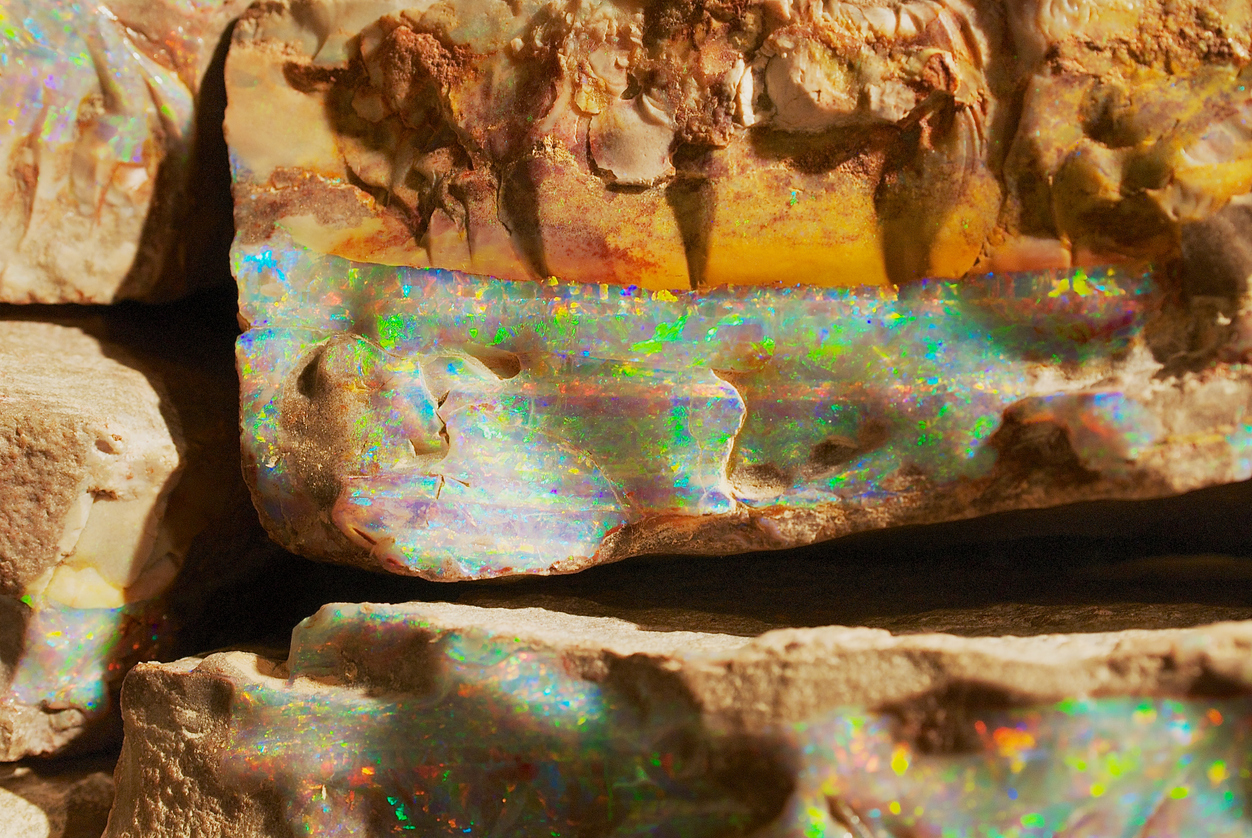From Mine to Market: Discovering the Journey of Opal Gemstones with Wigmore Trading
From Mine to Market: Discovering the Journey of Opal Gemstones with Wigmore Trading
Are you ready to embark on a thrilling adventure through the shimmering world of opal gemstones? Join us as we delve into the captivating journey of these mesmerizing gems, from their humble beginnings deep within the earth’s crust to their elegant presence in jewelry stores around the globe. In collaboration with Wigmore Trading, a leading player in the opal industry, we’ll unveil all the secrets and wonders that make opals truly one-of-a-kind. So fasten your seatbelts and get ready for an exhilarating ride – it’s time to discover the fascinating tale behind opal gemstones!
Introduction to Opal Gemstones
Opal gemstones are one of the most unique and captivating gems in the world. They have been admired and sought after for centuries, with their mesmerizing play of colors that seem to shift and change with every movement. But beyond their stunning appearance, opals have a fascinating journey from being mined in remote locations to being sold in markets all over the world.
In this section, we will take you on an introductory journey into the world of opal gemstones – from their formation to their various types and characteristics.
Formation of Opals
Opals are formed through a natural process that takes millions of years. They are created when silica-rich water seeps into cracks and spaces within rocks, usually sandstone or basalt. Over time, this water evaporates, leaving behind solid deposits of silica which forms into tiny spheres stacked together like marbles.
The unique quality of opals lies in these tiny spheres as they diffract light passing through them, creating a rainbow effect known as “play-of-color”. The size and arrangement of these spheres determine the type and intensity of colors seen in an opal.
Types of Opals
Opals come in a variety of types, each with its own distinct characteristics. The two main categories are precious opals and common opals.
Precious opals include black opal, white opal, boulder opal, crystal (or water) opal, fire (or harlequin) opal and matrix/opal potch.
The Mining Process of Opals
Opals are one of the most unique and mesmerizing gemstones in the world. They are known for their stunning play of colors, with each gemstone showcasing a unique combination of hues that seem to dance within the stone. However, many people may not be aware of how these precious gems are actually mined and brought to market. In this section, we will take a closer look at the mining process of opals.
1. Location and Exploration:
The first step in mining opals is to locate potential deposits. Opal mines can be found in various parts of the world including Australia, Ethiopia, Mexico, Brazil, and even the United States. However, Australia is considered as the primary source for high-quality opals.
Once a potential mining site is identified, extensive geological surveys are conducted to determine the presence and quality of opal deposits. This process involves digging test holes and analyzing rock samples to confirm if there are viable opal deposits present underground.
2. Open Cut Mining:
Once a promising location has been identified and confirmed through geological surveys, open cut mining begins. This method involves removing layers of overburden (soil or rock covering the deposit) using heavy machinery such as bulldozers and excavators.
As the overburden is removed, miners use drills and explosives to create blast holes which break up large chunks of rock containing opal seams. The broken rocks are then transported to an extraction point where they are crushed into smaller pieces for further processing.
Wigmore Trading: Connecting Miners to Buyers
Wigmore Trading is a leading company in the opal gemstone industry, with a strong focus on connecting miners to buyers. This unique business model allows for a more streamlined and efficient process, benefiting both parties involved. In this section, we will delve into how Wigmore Trading facilitates the journey of opal gemstones from the mine to the market.
At its core, Wigmore Trading acts as a bridge between miners and buyers. The company works closely with opal miners located in different regions around the world, including Australia, Mexico, Ethiopia, and Indonesia. These partnerships allow Wigmore Trading to have access to high-quality opals directly from the source.
One of the primary challenges that miners face is finding reliable buyers for their precious gems. This can be especially difficult for small-scale or independent miners who do not have established connections in the industry. By partnering with Wigmore Trading, these miners have a trusted platform to showcase their products and reach potential buyers worldwide.
On the other hand, buyers can also benefit greatly from working with Wigmore Trading. As an established and reputable company in the industry, they offer assurance of quality and authenticity. Each gemstone goes through rigorous testing and certification processes before being offered to buyers.
Moreover, Wigmore Trading’s extensive network allows for a diverse range of opals to be available to buyers. From classic Australian black opals to rare Mexican fire opals and everything in between – customers are spoilt for choice when it comes to selecting their desired gemstone.
The Journey of Opals from Mine to Market
Opal gemstones are one of the most unique and mesmerizing gems in the world, with their fiery display of colors and captivating patterns. These rare treasures are found in various parts of the globe, but Australia is known as the primary source of opals. The journey of opals from mine to market is a fascinating process that involves multiple steps and careful handling.
Mining:
The first step in the journey of opals is mining. Opals are formed from silicon dioxide, which is deposited when water flows through underground rocks. This process can take millions of years, resulting in precious stones hidden deep beneath the earth’s surface. Mining for opals requires specialized knowledge and skills, as well as specialized tools and equipment. Miners have to navigate through rough terrain and use techniques such as drilling, digging, and blasting to extract these valuable gemstones.
Sorting and Grading:
Once extracted from the mines, raw opal stones go through a sorting process where they are separated based on their size, shape, color, clarity, and other characteristics. This step is essential as it determines the value and quality of each stone. After sorting, opal gems are graded according to a standardized system based on factors such as brightness, pattern complexity, play-of-color intensity, etc.
Quality Control and Certification of Opals
Quality control and certification are crucial aspects of the opal mining and trading industry. Opals are highly coveted gemstones, known for their unique play of colors and rarity. As such, it is important to ensure that they meet certain standards of quality before being sold in the market.
At Wigmore Trading, we understand the importance of quality control in every step of the journey from mine to market. Our rigorous quality control process ensures that our opals are not only beautiful but also ethically sourced and responsibly handled.
One of the first steps in our quality control process is obtaining a mining permit from the relevant authorities. This ensures that our operations comply with all environmental regulations and ethical practices. We take great care to minimize any negative impact on the environment during our mining activities.
Once our opals have been extracted from the ground, they go through a thorough sorting process. Our experienced gemologists carefully sort through the rough stones, looking for any defects or flaws that may affect their overall quality. Those that do not meet our high standards are rejected at this stage.
The next step in our quality control process is cutting and polishing. Unlike other gemstones, opals require special handling due to their delicate nature. At Wigmore Trading, we work with skilled lapidaries who have years of experience in cutting and polishing opals to bring out their unique colors and patterns.
The Impact of Opal Mining on Local Communities
Opal mining is a significant industry in many parts of the world, with Australia being the largest producer of this stunning gemstone. While opal mining can bring economic benefits to communities, it also has a significant impact on the local community and its residents.
One of the most notable impacts of opal mining on local communities is the creation of job opportunities. In Australia alone, opal mining employs thousands of people, providing them with stable incomes and supporting their families. This has greatly contributed to the growth and development of many small rural towns where opal mines are located.
However, along with job opportunities, there are also social impacts on these communities. The influx of workers into small towns can put pressure on resources such as housing and infrastructure, leading to higher living costs for locals. Additionally, some miners may engage in activities that disrupt the peace and tranquility of these once-quiet towns.
Another impact that opal mining has on local communities is environmental degradation. The process often involves digging deep into the ground using heavy machinery, which can cause soil erosion and damage to vegetation. In some cases, mines may also produce toxic waste that can potentially harm surrounding ecosystems if not properly managed.
Moreover, traditional owners and indigenous communities who have lived in these areas for generations may also face displacement due to mine developments. Their cultural heritage sites could be destroyed or disturbed during exploration or extraction processes.
Sustainable Practices in the Opal Industry
The opal industry is a significant contributor to the global gemstone market, with Australia being the world’s largest producer of this unique and highly prized gemstone. However, with the increasing demand for opals and the pressure to meet production targets, there has been growing concern about the environmental and social impact of mining practices on local communities and ecosystems. In response to these concerns, sustainable practices have become a crucial focus in the opal industry.
Sustainable practices in the opal industry involve implementing environmentally responsible methods for mining and processing opals, as well as promoting ethical and fair trade practices. These efforts aim to minimize negative impacts on the environment while also ensuring that local communities benefit from the economic opportunities provided by the opal trade.
One major area of focus for sustainability in opal mining is reducing carbon emissions and energy consumption. Traditional open-cut mining techniques can be energy-intensive and contribute significantly to greenhouse gas emissions. To combat this, many companies are switching to more sustainable underground mining methods that require less energy and have a smaller carbon footprint.
Another important aspect of sustainable opal production is reducing water usage. Opals are typically found in arid regions where access to water is limited, so it is essential to use it efficiently. Companies are investing in technologies such as greywater recycling systems and drip irrigation techniques to reduce their water footprint.
Common Misconceptions about Opals
Opal gemstones have long been revered for their unique and mesmerizing beauty. However, they are also surrounded by many misconceptions that can often lead to confusion and misunderstandings. In this section, we will debunk some of the most common misconceptions about opals.
1. All Opals are White with Rainbow Flashes
One of the biggest misconceptions about opals is that they all have a white base color with rainbow flashes. While this type of opal, known as “precious opal,” is certainly one of the most popular varieties, there are actually many other types of opals in different colors and patterns.
For example, fire opals feature vibrant shades of orange and red, while black opals display deep blue or green hues on a dark background. Boulder opals have a distinctive matrix pattern, making them highly sought after by collectors. It’s important to note that the color and pattern of an opal depend on its origin and formation process.
2. Opals are Bad Luck
This myth has been perpetuated by old superstitions and folklore, particularly in Western cultures. However, there is no scientific evidence to support the idea that opals bring bad luck or misfortune to their wearers.
In fact, throughout history, opal has been regarded as a stone that brings good luck and prosperity to those who possess it. In ancient Rome, it was believed to symbolize hope and purity, while in ancient Greece it was associated with love and passion.
The Different Types and Colors of Opals
Opals are one of the most unique and mesmerizing gemstones in the world. They are known for their stunning display of colors, often referred to as the “play-of-color”. This phenomenon is caused by the diffraction of light through tiny silica spheres that make up the opal. Opals come in a variety of types and colors, making each one truly one-of-a-kind. In this section, we will dive into the different types and colors of opals found around the world.
Types of Opals:
1. White Opal:
White opal is also known as “milky” or “light” opal. It is characterized by its pale white or cream body color with flashes of vibrant play-of-color. These opals are usually found in Australia and are considered to be more common compared to other types.
2. Black Opal:
Black opal is highly coveted for its dark body tone, which ranges from dark gray to black, making the play-of-color appear even more vivid and intense. These precious gems are mainly sourced from Lightning Ridge in New South Wales, Australia.
3. Boulder Opal:
Boulder opals have a unique appearance due to their host rock matrix that forms naturally within them. The matrix can vary from ironstone to sandstone and provides a beautiful contrast to the colorful opal patches.
How to Care for Your Opal Gemstones?
Opal gemstones are unique and stunning gems that have been treasured for centuries. They can be found in a variety of colors, from vibrant greens and blues to warm oranges and reds. However, with their delicate nature, it is important to properly care for these precious gemstones to ensure their longevity and beauty. In this section, we will discuss the steps you should take to care for your opal gemstones.
1. Avoid harsh chemicals
One of the most important things to keep in mind when caring for your opal gemstones is to avoid exposure to harsh chemicals. These include chemicals commonly found in household cleaning products, as well as beauty products such as hairspray and perfume. These substances can cause damage or discoloration to your opals over time.
2. Protect from heat and extreme temperature changes
Opals are sensitive gems that can easily crack or lose their color when exposed to high temperatures or sudden changes in temperature. It is best to avoid wearing your opals while bathing or swimming as hot water can damage them. Additionally, do not leave them near sources of heat such as heaters or direct sunlight.
3. Handle with care
Opals are relatively soft stones compared to other gems like diamonds or sapphires, making them more susceptible to scratches and chips if mishandled. When handling your opal jewelry, make sure your hands are clean and dry, and avoid dropping them on hard surfaces.
Conclusion
As we have seen, the journey of opal gemstones from mine to market is a long and complex process that involves many steps and individuals. From the miners who work tirelessly in harsh conditions to extract these precious gems, to the traders who travel across borders to bring them to market, each person plays an important role in making these stunning opals available for us to admire and enjoy. We hope you have gained a deeper understanding and appreciation for this remarkable journey of opal gemstones with Wigmore Trading.








Comments are closed.